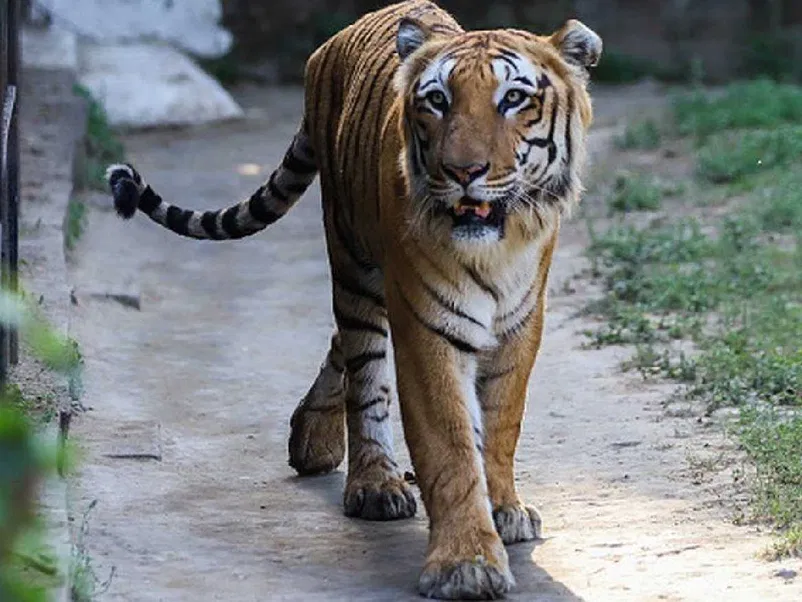Environment Ministry rules out poaching as main reason, claims natural deaths are on the rise.

Photo for representational purpose only
New Delhi: At a time, when yet another Cheetah death hogs the limelight, India has already lost more than 100 tigers in the first six months of 2023, a year that has seen glorious celebrations of 50 years of Project Tiger.
Official data from the National Tiger Conservation Authority (NTCA) shows that as of July 10 this year, India had lost 106 tigers, 100 of them before June 30.
Although, there is no official classification for reasons of death as yet in public domain – ‘natural’, ‘poaching’ or ‘unnatural but not poaching’, the Ministry of Environment, Forest and Climate Change (MoEF&CC) denied ‘poaching’ was the biggest cause and said most of these deaths are likely to be natural as the number of tigers has increased substantially.
“We have a healthy rate of 6% growth of tigers in the wild, highest for anywhere in the world. Given the average age of tigers at 10-12 years, deaths due to natural causes are within reasonable limits. Also, tigers have a 50% neonatal mortality,” said S P Yadav, Additional Director General (Project Tiger), MoEF&CC.
Even when Yadav agreed that poachers are always on the prowl, he said, deaths due to natural causes need not be a cause of alarm. “However poaching driven due to demand for tiger body parts in consumer countries is a cause of concern.”
Of these 100 deaths, the three leading states that have seen high casualties include Madhya Pradesh (27 tigers dead), Maharashtra (21) and Kerala (10).
On April 9, 2023, coinciding with the 50 years of Project Tiger, Prime Minister Narendra Modi had announced the latest Tiger estimation numbers for 2022 at 3,167 tigers in the wild. The Ministry of Environment, Forest and Climate Change (MoEF&CC) is all set to declare state-wise data by month end.
Including the two Cheetah deaths last week, as many as eight Cheetahs – including three cubs born in India – have died at the Kuno National Park in Madhya Pradesh over the last four months. The Park is now left with 15 Cheetahs.
Increased patrolling, better detection
Since 2012, when the NTCA started keeping scientific records of tiger mortality, there have been 120-odd deaths in a year; 127 in 2021 was the highest, followed by 121 in 2022 & 2016. To put it in context, the NTCA data shows that the death of the 100th tiger on June 23 in 2023 as against the 100th tiger death in 2022 and 2021 respectively had occurred on November 29, 2022 and October 2, 2021.
Explained an official from the NTCA, “Since it began in 2012, there is a very systematic approach towards dealing with tiger deaths. To start with, all deaths are considered ‘poaching’. But after going through the post mortem report, forensic lab report and, of course, circumstantial evidence, the tiger deaths are then categorised as ‘natural’, ‘poaching’ or ‘unnatural but not poaching.’”
Tiger deaths happen for multiple reasons; these happen inside and outside the tiger reserve areas and then there are seizures of tiger skin / bone (i.e. officials are not sure, where exactly the death occurred).
An analysis of NTCA data showed that out of the total 762 deaths between 2012 and 2020, 417 were attributed to natural causes; 44 to unnatural but not poaching; 193 to poaching and 108 to Seizure. The NTCA was still processing the data for 22 deaths in 2019 and 73 deaths in 2020 for ascertaining the exact cause.
Explained Yadav, “There is a robust procedure for identifying the cause of death of any tiger. We don’t just carry out post-mortem, but we send viscera samples for forensic analysis to ascertain if the tiger was poisoned by any means. This forensic analysis takes a lot of time. We are trying to expedite the procedure.”
Poaching not the top reason?
The NTCA data also indicates that from January 1 to July 10, 2023, of the 106 tiger deaths, 54 happened inside Tiger reserves while 52 were outside. Similarly, in 2022, out of the 121 deaths, 69 happened inside while 52 happened outside the tiger reserves. Similarly, in 2021, of the 127 tiger deaths, as many as 65 happened inside the tiger reserves and 62 outside.
Statistics showed a comparable trend in previous years. Of the 1,062 tiger deaths between 2012 and 2022 (up to July 2022), as many as 53.20% of all mortality took place inside the tiger reserves, 35.22% outside the boundary of tiger reserves and the rest 11.58% were seizures.
On June 29, the Wildlife Crime Control Bureau (WCCB) had issued a ‘red alert’ cautioning against the organised hunting gangs on the prowl areas outside the tiger reserves. This was especially applicable for tiger reserves in Uttarakhand, Uttar Pradesh, Madhya Pradesh, Assam, Maharashtra and several tiger bearing areas from Vidarbha region of Maharashtra and Balaghat in adjoining areas of Madhya Pradesh. The WCCB had asked for immediate intensification of patrolling in all sensitive areas.
Said an official, on conditions of anonymity, “This particular red alert by WCCB was prompted by seizures of four tiger skins, two on our side and two in Nepal. Our intelligence also received definite inputs from backward tracking and hence the alert.”
“In 2023, 13 tiger skins and bones were seized. The demand due to Chinese pharmacopoeia has increased post-Covid,” the official said.
Ravi Chellam, wildlife conservationist and coordinator for Biodiversity Collaborative, an advocacy group of scientists and scientific institutions, said, “Nobody can guarantee that every dead tiger is being accounted for. These numbers are the minimum. Unlike the Cheetahs, no tiger has 24X7 surveillance. So, it is a question of detection. If it is not detected, it won’t get counted.”
“We don’t know if the effort put in (for monitoring and detecting tiger mortality) is constant in terms of effort invested and spatial coverage, over the years. The results will be influenced by the amount of effort put in for field patrolling and intelligence gathering. Data related to such efforts is not available in the public domain,” Chellam said.
“Started in 2010 and improved over the years, the Ministry uses M-STRIPES software for tech-enabled patrolling. This has directly increased our detection (of deaths) rate on the one hand and on the other, also helped us prevent poaching inside the tiger reserves,” Yadav said, adding, “Poaching inside the tiger reserve has drastically come down now but tigers outside tiger reserves have become vulnerable.”
Media reports from earlier years mentioned that as many as 384 tigers were killed by poachers across the country between 2008 and 2018 while between January 2013 to December 2022, tiger deaths due to poaching had come down to at least 57.
However, for 2023, the exact causes of 100 plus tiger mortality is not yet known and “it will be premature to call it an alarming situation just yet,” said another expert. In fact, agreeing to Yadav’s claim, Bilal Habib, expert in carnivore ecology and Professor at the Wildlife Institute of India (WII), Dehradun, said: “There was a time when it was feared that Indian tigers would be extinct because of poaching. We had examples like Sariska where the number of tigers had gone down to zero because of poaching. But no, it did not happen. There are a number of systems in place to reduce poaching and, in fact, poaching from inside the tiger reserves has come down drastically.”
Explaining why poaching comes as the third biggest cause for tiger mortality, Habib said, “After ‘natural deaths’, it is the accidental deaths – such as electrocution or in road accidents – that are the second biggest causes of tiger deaths.”
For instance, as many as 26 tigers have died across India between January 2010 and January 2021, with 12 of them losing their lives in road accidents and 14 in rail accidents.
The Ministry of Environment, Forest and Climate Change (MoEF&CC) is likely to release the details of Tiger Estimation data for 2022 on the Global Tiger Day, i.e. July 29 or thereabouts.
(This story first appeared on news9live.com on Jul 18, 2023 and can be read here.)



